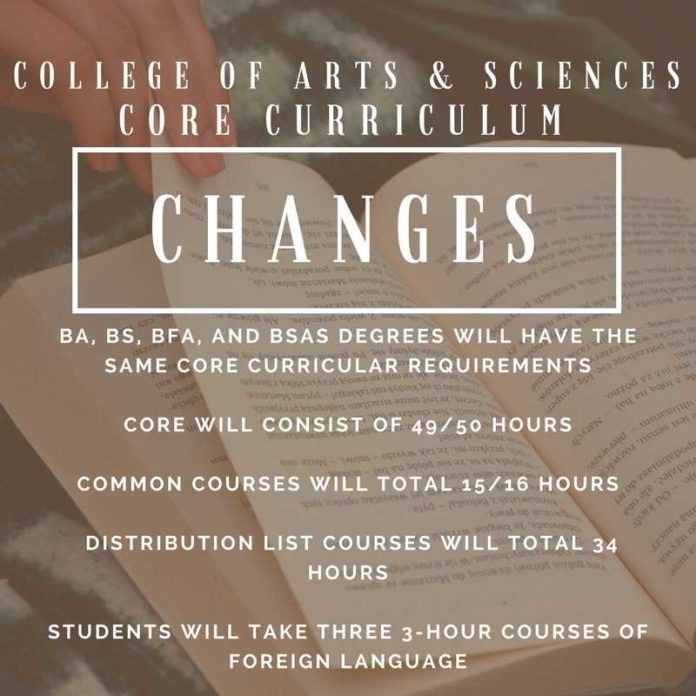By Thomas Moran | Staff Writer
For the first time since World War II the College of Arts and Sciences is getting a new core curriculum.
The new curriculum, officially announced this week in a letter from Dr. Lee Nordt, dean of the College of Arts and Sciences, will take effect in fall 2019.
There are currently four different lists of core requirements for the various degrees, but in the new vision, all four degrees would share the same list of requirements. The five common courses that the degrees currently share are Chapel, U.S. Constitution, Christian Scriptures and Christian Heritage.* With the new core, there would be eight common courses: Chapel, U.S. Constitution, Christian Scriptures, Christian Heritage, Thinking and Writing, U.S. History in Global Perspective, Cultural Events Experience and Civic Engagement Seminar.
Bachelor of Arts and Bachelor of Science degrees currently require up to 79 hours in core courses, so the change to a 49/50 hour requirement may make it easier for students to pursue multiple majors, minors or electives. It is also intended to eliminate some of the difficulties pre-med students face if they decide to major in humanities or social sciences later on.
The current core curriculum had not been assessed or re-evaluated in decades and had grown somewhat haphazardly through the years, Nordt said. The current core, which has increased to around 70 credit hours, is one of the largest in the nation.
“We couldn’t even find the last time anyone had ever looked at our core,” Nordt said.
In 2012, the College of Arts and Sciences re-evaluated the current core and found that it did not provide a sufficiently “transformational education,” one of the five tenets listed in Baylor’s official vison document, Pro Futuris.
Dr. Blake Burleson, associate dean of the College of Arts and Sciences, played an integral role throughout the past six years and will continue to do so until the new core curriculum’s enactment in 2019. One primary issue that he and many other contributors found with the current curriculum is its inconsistency across the BA, BS, BFA, and BSAS degrees.
“Each of these degrees have different cores,” Burleson said.
After establishing that change was necessary, Dean Nordt appointed a select group of faculty, each individual representing a different field of study, to construct a vision statement for the new core curriculum. Over a year later, the document was presented to the chairs of the 25 departments and there was unanimous agreement and support for the vision.
Written in the vision statement and affirmed in its emblem, the new core supports scientific reasoning, critical thinking, civic engagement, creativity, and Christian tradition for the purpose of helping students to become leaders in faith and better citizens of a democracy, Burleson said.
With the vision in mind, a 40-member pan-departmental task force held meetings for over a year to determine the size and content of the new curriculum based on the vision statement.
“It was the most extensive kind of process that I have ever seen during my 30 years at Baylor,” Burleson said. “It was very demanding and very difficult.”
As chair of the theater arts department, Dr. Stan Denman said it was challenging to develop a core that takes into account the needs of each department, while also providing an education that was up-to-date and progressive.
“[We were] trying to look at how education has changed, trying to look at how our world has changed, how Baylor has changed, and taking all those things into consideration to make a new curriculum,” Denman said. “Change is scary. I think there were a lot of people that were scared of the new curriculum because there are a lot of questions, legitimate questions.”
Ultimately, Denman said he is pleased with the finalized curriculum plan and is proud of the dean’s office for its constant commitment to developing a core that is best for the students.
The final stage of the seven-year process, currently underway, is to create and retune courses and to implement the core in 2019.
Nordt, Burleson and Denman all foresee a positive future with the new core curriculum in place.
“What we are hoping is that it will actually encourage students to do more exploration outside their field,” Denman said.
Like most students, Telluride, Colo., junior Marygrace Greene is excited about the smaller 50 credit hour curriculum, and mourns only the fact that it was not enacted during her time at Baylor.
“Honestly, I think that’s a much more beneficial idea considering the fact that it would allow for more hours spent in your field of study,” Greene said. “I really wish they would have changed it earlier so it would apply to us. I’m interested to see how it plays out.”
The college has yet to decide whether or not the new curriculum will apply to current students or only to students matriculated in the fall of 2019.
* This article was updated at 12:04 p.m. on Jan. 31.






